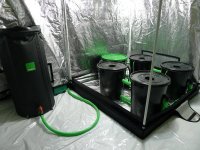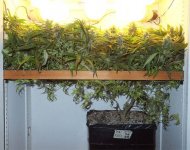Hello IcMag!
New around these parts, so please dont bite!
I've recently upgraded from coco to RDWC, undercurrent style, though I think mine is waaaaay cooler

Anyway, doing tons of research, lots of questions pop in my mind to make our lives easier, better, cheaper, more silent, healthier etc etc...
I think I've got a pretty solid knowledge already on the subject, from Henry's Law to excessive aerobic depletion (too much tea etc), temperature control and even salt concentration, elevation, pathogens etc etc etc.. and how they influence the over saturation of 02 in H20 and provide all the goodies we love giving our root zone.
But, what I cannot find for the life of me is one piece of information that can effectively revolutionize our methods potentially making our lives easier and cheaper.
Unfortunately, DO meters that are actually useful are way too expensive. How I wish I could have one to test all my hypotheses...
My goal is to get rid of the airpump = less noise, less disease, lesser H20 heat, less maintenance, less electric cost etc etc.
The question being;
If all conditions remain equal, (water temp, pressure, recirc flow etc..) - once you oversaturate the water with oxygen - if the airpump is shut-off, how long will it take for the water to un-saturate back to baseline environmental DO ?
Why the question?
- Any decent RDWC will recircs at least about 6 to 10x the hour. That means that all the water flows around once every 6 to 10 minutes.
- At 19ºC (66ºF) maximum saturation of pure water is around 9mg/L, at sea level with 0.00ppm salinity (basically, RO water)
- RO, or even tap water, should be (extremely variable I know...) 4 to 7ppm from what I've gathered... lets say 5ppm
- So imagine we increased 4ppm, using airpumps, to raise DO from 5ppm to 9ppm. Imagine for a second that you turn off the airpump... how long would it take for the water to go from 9ppm oxygen back down to 5ppm?
Because, if it take longer that the time it take to recirc the system 1x (around 10 minutes) - then we are wasting electricity (both airpump and chillers), producing heat, introducing pathogens, making lots of noise, and basically doing very very very little for plant health.
I've only found 1 semi-scientific paper that addresses it. They were comparing 3 distinct methods for determining DO. With all three methods, I was shocked at how long DO lowers - check it out.

It suggests it takes about 24h to go from 7ppm down to 6ppm of DO.
If this this is true, we seriously have to address the whole airpump practice. Essentially, we could oversaturate just once or twice a day for a few hours, using either airpump, waterfall, whatever.
I have always been much more inclined to do flooming (correctly spelled fluming) - and for those who argue about bubbles and water movement/mixing - fluming does a heck lot more of it too.
Its not really about the cost for me, it more about noise and heat to be honest...
wadda'ya think?
New around these parts, so please dont bite!
I've recently upgraded from coco to RDWC, undercurrent style, though I think mine is waaaaay cooler
Anyway, doing tons of research, lots of questions pop in my mind to make our lives easier, better, cheaper, more silent, healthier etc etc...
I think I've got a pretty solid knowledge already on the subject, from Henry's Law to excessive aerobic depletion (too much tea etc), temperature control and even salt concentration, elevation, pathogens etc etc etc.. and how they influence the over saturation of 02 in H20 and provide all the goodies we love giving our root zone.
But, what I cannot find for the life of me is one piece of information that can effectively revolutionize our methods potentially making our lives easier and cheaper.
Unfortunately, DO meters that are actually useful are way too expensive. How I wish I could have one to test all my hypotheses...
My goal is to get rid of the airpump = less noise, less disease, lesser H20 heat, less maintenance, less electric cost etc etc.
The question being;
If all conditions remain equal, (water temp, pressure, recirc flow etc..) - once you oversaturate the water with oxygen - if the airpump is shut-off, how long will it take for the water to un-saturate back to baseline environmental DO ?
Why the question?
- Any decent RDWC will recircs at least about 6 to 10x the hour. That means that all the water flows around once every 6 to 10 minutes.
- At 19ºC (66ºF) maximum saturation of pure water is around 9mg/L, at sea level with 0.00ppm salinity (basically, RO water)
- RO, or even tap water, should be (extremely variable I know...) 4 to 7ppm from what I've gathered... lets say 5ppm
- So imagine we increased 4ppm, using airpumps, to raise DO from 5ppm to 9ppm. Imagine for a second that you turn off the airpump... how long would it take for the water to go from 9ppm oxygen back down to 5ppm?
Because, if it take longer that the time it take to recirc the system 1x (around 10 minutes) - then we are wasting electricity (both airpump and chillers), producing heat, introducing pathogens, making lots of noise, and basically doing very very very little for plant health.
I've only found 1 semi-scientific paper that addresses it. They were comparing 3 distinct methods for determining DO. With all three methods, I was shocked at how long DO lowers - check it out.
It suggests it takes about 24h to go from 7ppm down to 6ppm of DO.
If this this is true, we seriously have to address the whole airpump practice. Essentially, we could oversaturate just once or twice a day for a few hours, using either airpump, waterfall, whatever.
I have always been much more inclined to do flooming (correctly spelled fluming) - and for those who argue about bubbles and water movement/mixing - fluming does a heck lot more of it too.
Its not really about the cost for me, it more about noise and heat to be honest...
wadda'ya think?





